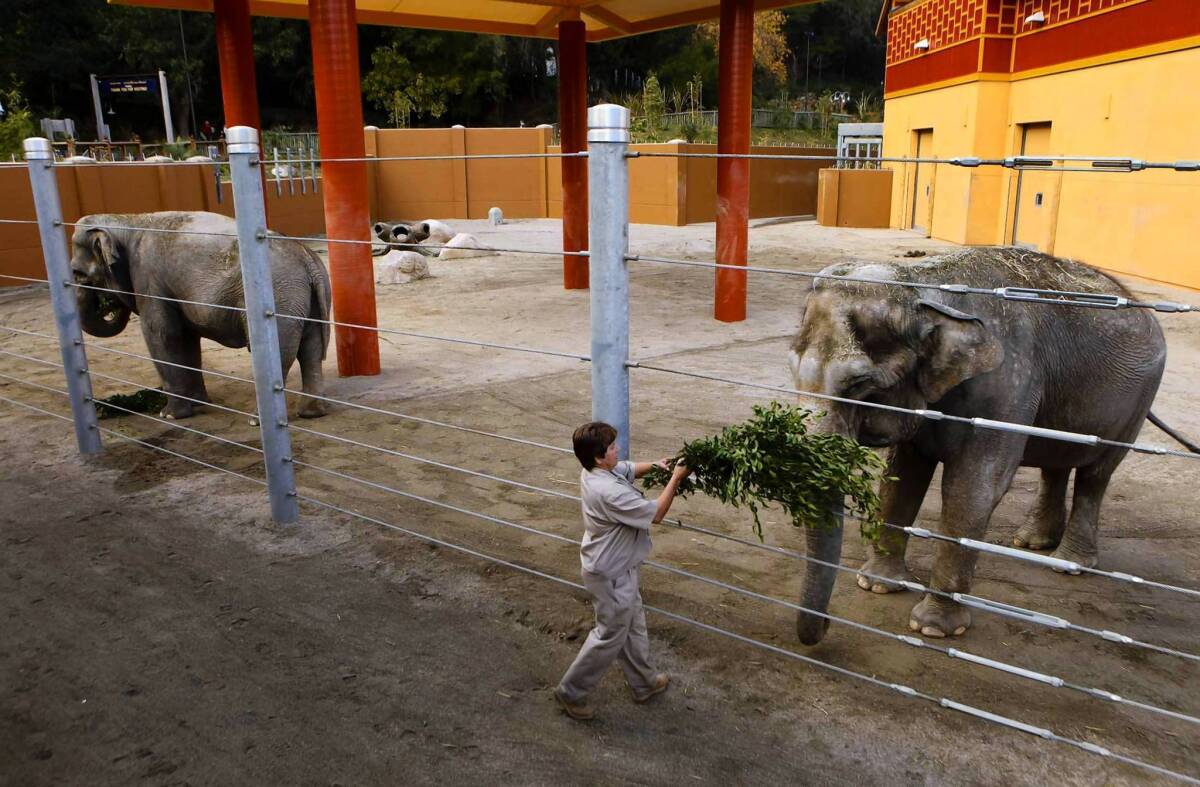Judge assails Los Angeles Zoo’s care of elephants

- Share via
A judge on Tuesday harshly criticized the Los Angeles Zoo for its care and housing of elephants and ordered changes to improve the animals’ welfare, but also found that the treatment did not amount to abuse and the exhibit can remain open.
“This case raises the question of whether the recreational or perhaps educational needs of one intelligent mammal species outweigh the physical and emotional, if not survival, needs of another,” Los Angeles County Superior Court Judge John L. Segal wrote in his 56-page opinion. “Existing California law does not answer that question.”
In his ruling, Segal ordered that elephants at the zoo’s “Elephants of Asia” exhibit be exercised at least two hours a day, and the soil be rototilled to lessen the impact on their joints. He also entered an injunction banning the use of certain disciplinary tools, including electric shock and a barbed stick known as a “bull hook” — devices the zoo said it no longer uses.
Segal’s decision was based on evidence presented during a closely watched six-day trial last month, during which plaintiffs argued that conditions in the exhibit were inadequate, damaging and abusive. They asked that the exhibit be closed and the elephants sent to a sanctuary.
The city, which in recent years spent $42 million to revamp the exhibit, maintained that its elephants — Billy, Tina and Jewel — were happy and healthy and that the exhibit met accepted standards. They contended that much of the suit was based on outdated information.
The judge’s opinion expounded on appropriate elephant foot care, a male elephant’s extended period of sexual arousal and how best to interpret the animals’ head-bobbing — whether as a sign of distress or of happiness — and concluded that the elephants’ existence is “empty, purposeless, boring and occasionally painful” but not abusive in violation of state law.
Segal was highly critical of zoo officials, calling them “delusional” in the opinion. He painted a particularly unflattering portrait of the zoo’s “senior elephant keeper,” who he wrote displayed at trial “somewhat shocking gaps in her knowledge” and “surprising misconceptions” and who maintained an “anthropomorphic fantasy” about the animals’ happiness.
Citing the hardness of the ground the animals walk on, the small amount of space, electrified trees and sexual frustration, the judge wrote that the L.A. Zoo exhibit was “not a happy place for elephants.”
The opinion was heralded as a victory years in the making by animal rights groups who have long attacked the elephant exhibit. Plaintiff Aaron Leider, a real estate agent who filed the lawsuit against the city as a taxpayer in 2007 with the late actor Robert Culp, said he was pleased the truth had come out about the exhibit and that he hoped the decision would lead to city officials reevaluating the zoo’s elephant program.
“We think the judge gleaned the facts and accurately assessed exactly what’s happening at the zoo,” said attorney David Casselman, who represented Leider at trial. “The truth is that life for an elephant at the L.A. Zoo is suffering, pain and premature death.”
Zoo Director John Lewis, who was a named defendant and testified at trial, said Tuesday the judge’s opinion was based on limited, narrow evidence that did not accurately reflect conditions at the zoo and that critics were trying to “drag the zoo down” based on history.
The day the judge was presented photo evidence of the exhibit’s soil being so hard that the elephants did not leave any footprints, Lewis went back to the zoo and saw that there were footprints all over the place, he said.
“It’s the zoo version of, ‘Do you still beat your wife?’” he said.
Lewis also defended his staff, saying they were competent and knowledgeable. Referring to the judge’s reliance on a world-renowned expert who studied wild African elephants, he said: “What we do have is experience in caring for animals in the zoo, and that can be very different from the way animals care for themselves in the wild.”
Segal wrote that he found most credible the expertise of Dr. Joyce Poole, a Cambridge- and Princeton-educated scholar of elephant behavior, who opined that Billy’s head-bobbing and rocking showed the animal was “stressed, frustrated, bored, unanimated and unhappy, and the zoo is not meeting his needs.”
The judge rejected the zoo officials’ contention that Billy’s actions were a sign of happiness and anticipation akin to a dog’s tail-wagging.
More to Read
Sign up for Essential California
The most important California stories and recommendations in your inbox every morning.
You may occasionally receive promotional content from the Los Angeles Times.














